Marketing Management: Customer Value and Propositions
VerifiedAdded on 2019/09/23
|9
|3348
|154
Report
AI Summary
This report delves into the concepts of customer value and value propositions, examining their importance in achieving marketing objectives. It analyzes how UK supermarkets, particularly a local supermarket, deliver value to their customers. The report identifies different customer segments and their specific value expectations. It also includes a website analysis of a local supermarket and provides recommendations for improving value propositions using a value proposition builder model. The report concludes that managing value propositions is crucial for marketing success and competitive advantage.

Marketing Management- Masters Level
Paraphrase This Document
Need a fresh take? Get an instant paraphrase of this document with our AI Paraphraser
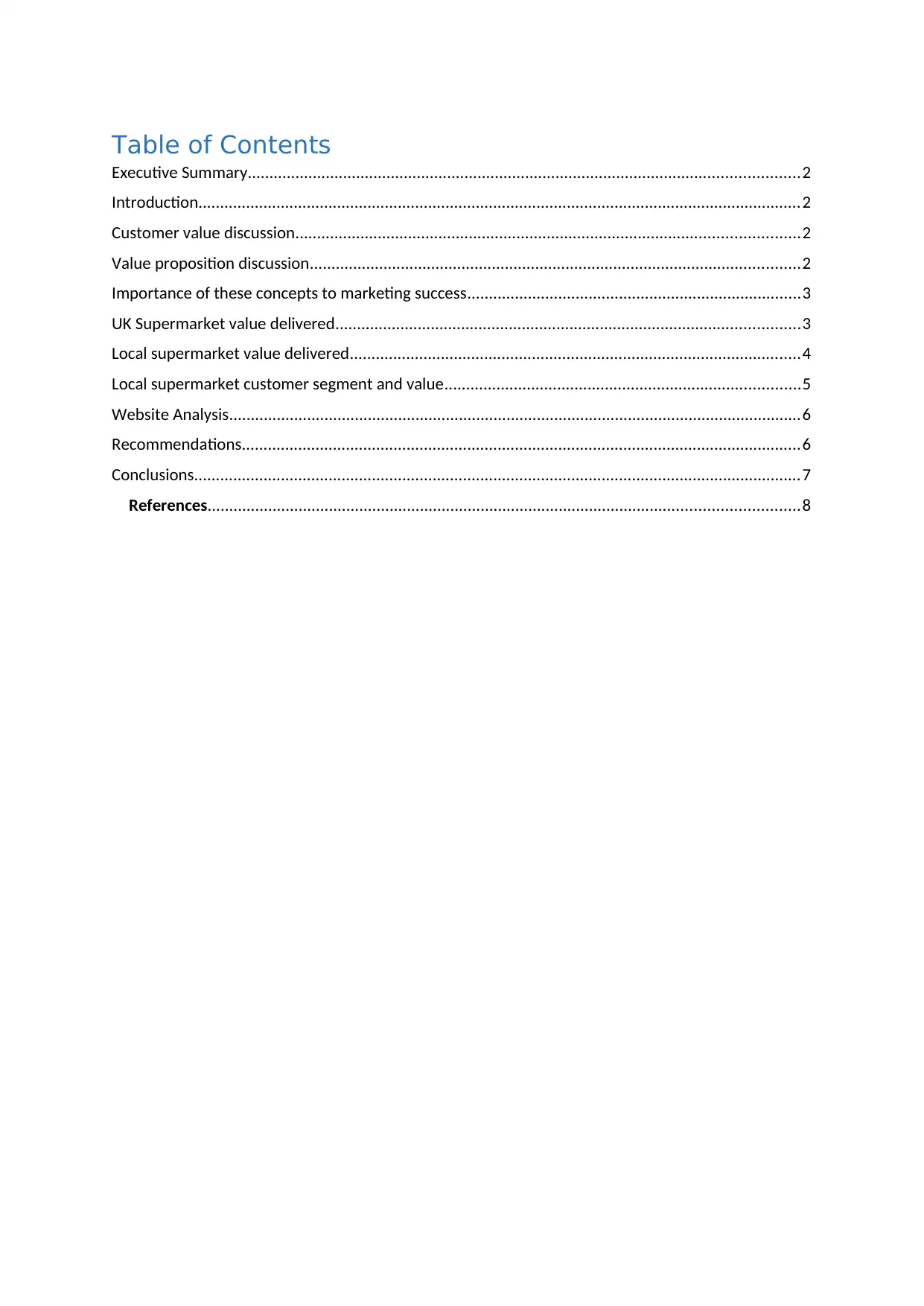
Table of Contents
Executive Summary...............................................................................................................................2
Introduction...........................................................................................................................................2
Customer value discussion....................................................................................................................2
Value proposition discussion.................................................................................................................2
Importance of these concepts to marketing success.............................................................................3
UK Supermarket value delivered...........................................................................................................3
Local supermarket value delivered........................................................................................................4
Local supermarket customer segment and value..................................................................................5
Website Analysis....................................................................................................................................6
Recommendations.................................................................................................................................6
Conclusions............................................................................................................................................7
References........................................................................................................................................8
Executive Summary...............................................................................................................................2
Introduction...........................................................................................................................................2
Customer value discussion....................................................................................................................2
Value proposition discussion.................................................................................................................2
Importance of these concepts to marketing success.............................................................................3
UK Supermarket value delivered...........................................................................................................3
Local supermarket value delivered........................................................................................................4
Local supermarket customer segment and value..................................................................................5
Website Analysis....................................................................................................................................6
Recommendations.................................................................................................................................6
Conclusions............................................................................................................................................7
References........................................................................................................................................8
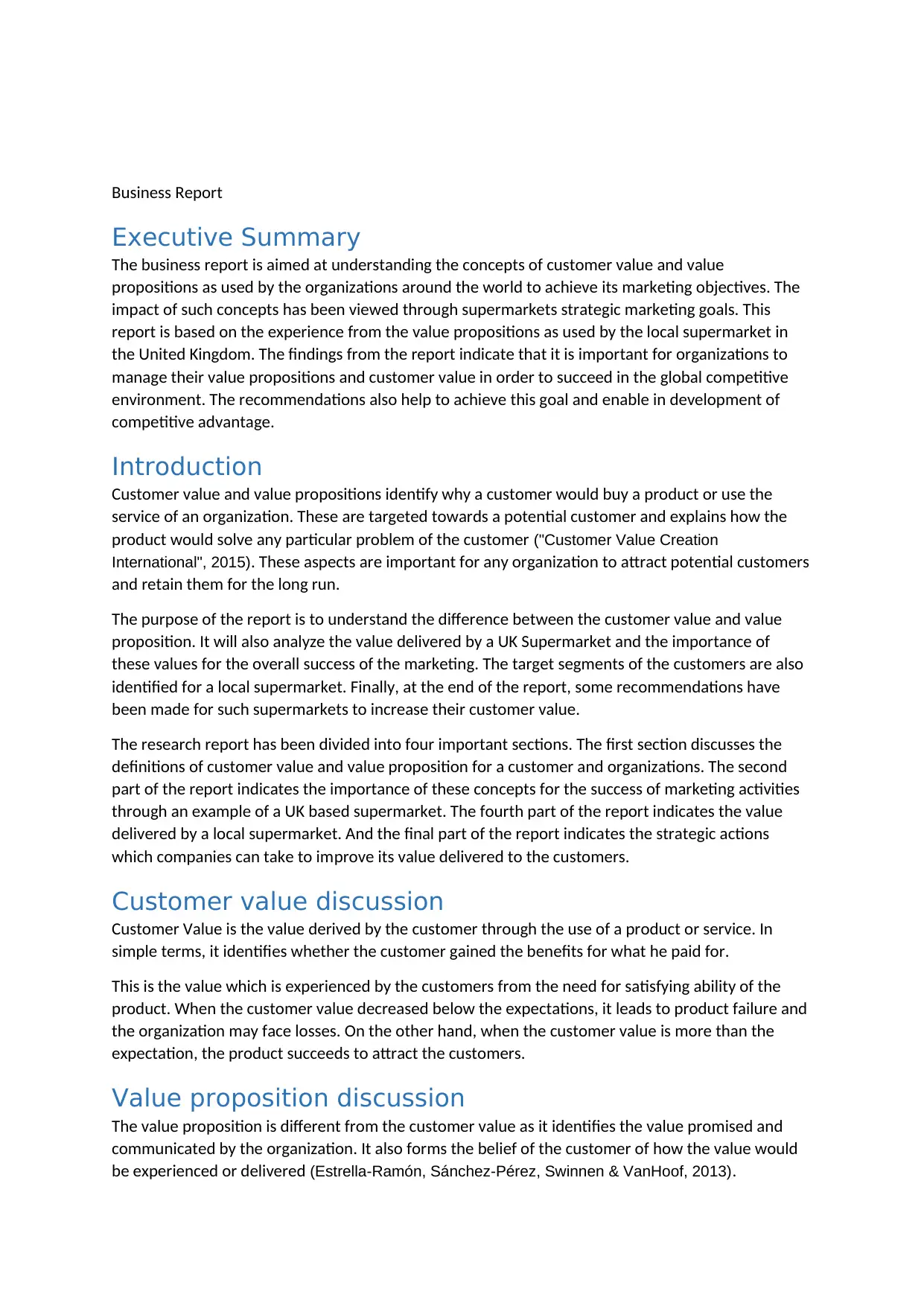
Business Report
Executive Summary
The business report is aimed at understanding the concepts of customer value and value
propositions as used by the organizations around the world to achieve its marketing objectives. The
impact of such concepts has been viewed through supermarkets strategic marketing goals. This
report is based on the experience from the value propositions as used by the local supermarket in
the United Kingdom. The findings from the report indicate that it is important for organizations to
manage their value propositions and customer value in order to succeed in the global competitive
environment. The recommendations also help to achieve this goal and enable in development of
competitive advantage.
Introduction
Customer value and value propositions identify why a customer would buy a product or use the
service of an organization. These are targeted towards a potential customer and explains how the
product would solve any particular problem of the customer ("Customer Value Creation
International", 2015). These aspects are important for any organization to attract potential customers
and retain them for the long run.
The purpose of the report is to understand the difference between the customer value and value
proposition. It will also analyze the value delivered by a UK Supermarket and the importance of
these values for the overall success of the marketing. The target segments of the customers are also
identified for a local supermarket. Finally, at the end of the report, some recommendations have
been made for such supermarkets to increase their customer value.
The research report has been divided into four important sections. The first section discusses the
definitions of customer value and value proposition for a customer and organizations. The second
part of the report indicates the importance of these concepts for the success of marketing activities
through an example of a UK based supermarket. The fourth part of the report indicates the value
delivered by a local supermarket. And the final part of the report indicates the strategic actions
which companies can take to improve its value delivered to the customers.
Customer value discussion
Customer Value is the value derived by the customer through the use of a product or service. In
simple terms, it identifies whether the customer gained the benefits for what he paid for.
This is the value which is experienced by the customers from the need for satisfying ability of the
product. When the customer value decreased below the expectations, it leads to product failure and
the organization may face losses. On the other hand, when the customer value is more than the
expectation, the product succeeds to attract the customers.
Value proposition discussion
The value proposition is different from the customer value as it identifies the value promised and
communicated by the organization. It also forms the belief of the customer of how the value would
be experienced or delivered (Estrella-Ramón, Sánchez-Pérez, Swinnen & VanHoof, 2013).
Executive Summary
The business report is aimed at understanding the concepts of customer value and value
propositions as used by the organizations around the world to achieve its marketing objectives. The
impact of such concepts has been viewed through supermarkets strategic marketing goals. This
report is based on the experience from the value propositions as used by the local supermarket in
the United Kingdom. The findings from the report indicate that it is important for organizations to
manage their value propositions and customer value in order to succeed in the global competitive
environment. The recommendations also help to achieve this goal and enable in development of
competitive advantage.
Introduction
Customer value and value propositions identify why a customer would buy a product or use the
service of an organization. These are targeted towards a potential customer and explains how the
product would solve any particular problem of the customer ("Customer Value Creation
International", 2015). These aspects are important for any organization to attract potential customers
and retain them for the long run.
The purpose of the report is to understand the difference between the customer value and value
proposition. It will also analyze the value delivered by a UK Supermarket and the importance of
these values for the overall success of the marketing. The target segments of the customers are also
identified for a local supermarket. Finally, at the end of the report, some recommendations have
been made for such supermarkets to increase their customer value.
The research report has been divided into four important sections. The first section discusses the
definitions of customer value and value proposition for a customer and organizations. The second
part of the report indicates the importance of these concepts for the success of marketing activities
through an example of a UK based supermarket. The fourth part of the report indicates the value
delivered by a local supermarket. And the final part of the report indicates the strategic actions
which companies can take to improve its value delivered to the customers.
Customer value discussion
Customer Value is the value derived by the customer through the use of a product or service. In
simple terms, it identifies whether the customer gained the benefits for what he paid for.
This is the value which is experienced by the customers from the need for satisfying ability of the
product. When the customer value decreased below the expectations, it leads to product failure and
the organization may face losses. On the other hand, when the customer value is more than the
expectation, the product succeeds to attract the customers.
Value proposition discussion
The value proposition is different from the customer value as it identifies the value promised and
communicated by the organization. It also forms the belief of the customer of how the value would
be experienced or delivered (Estrella-Ramón, Sánchez-Pérez, Swinnen & VanHoof, 2013).
⊘ This is a preview!⊘
Do you want full access?
Subscribe today to unlock all pages.

Trusted by 1+ million students worldwide
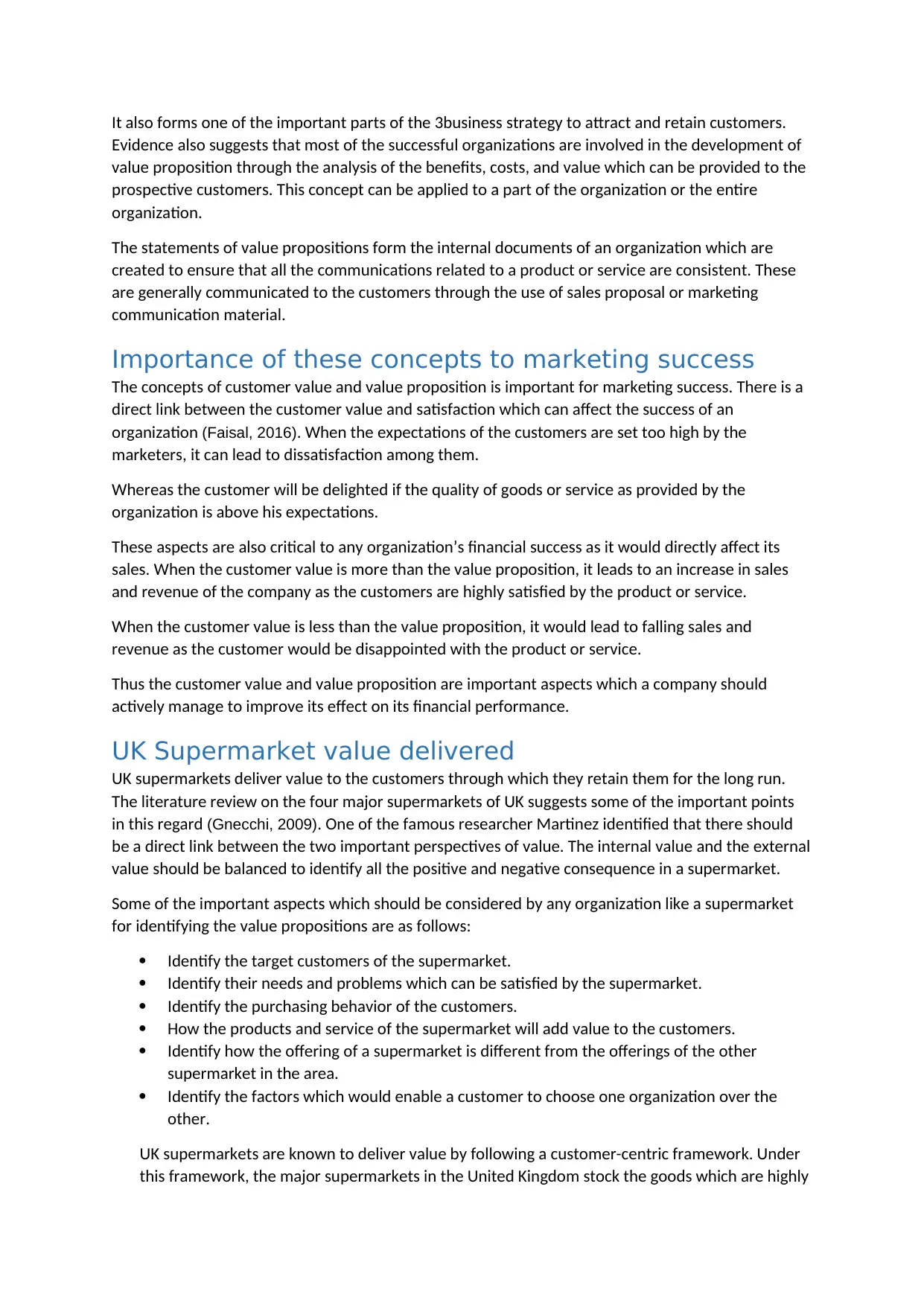
It also forms one of the important parts of the 3business strategy to attract and retain customers.
Evidence also suggests that most of the successful organizations are involved in the development of
value proposition through the analysis of the benefits, costs, and value which can be provided to the
prospective customers. This concept can be applied to a part of the organization or the entire
organization.
The statements of value propositions form the internal documents of an organization which are
created to ensure that all the communications related to a product or service are consistent. These
are generally communicated to the customers through the use of sales proposal or marketing
communication material.
Importance of these concepts to marketing success
The concepts of customer value and value proposition is important for marketing success. There is a
direct link between the customer value and satisfaction which can affect the success of an
organization (Faisal, 2016). When the expectations of the customers are set too high by the
marketers, it can lead to dissatisfaction among them.
Whereas the customer will be delighted if the quality of goods or service as provided by the
organization is above his expectations.
These aspects are also critical to any organization’s financial success as it would directly affect its
sales. When the customer value is more than the value proposition, it leads to an increase in sales
and revenue of the company as the customers are highly satisfied by the product or service.
When the customer value is less than the value proposition, it would lead to falling sales and
revenue as the customer would be disappointed with the product or service.
Thus the customer value and value proposition are important aspects which a company should
actively manage to improve its effect on its financial performance.
UK Supermarket value delivered
UK supermarkets deliver value to the customers through which they retain them for the long run.
The literature review on the four major supermarkets of UK suggests some of the important points
in this regard (Gnecchi, 2009). One of the famous researcher Martinez identified that there should
be a direct link between the two important perspectives of value. The internal value and the external
value should be balanced to identify all the positive and negative consequence in a supermarket.
Some of the important aspects which should be considered by any organization like a supermarket
for identifying the value propositions are as follows:
Identify the target customers of the supermarket.
Identify their needs and problems which can be satisfied by the supermarket.
Identify the purchasing behavior of the customers.
How the products and service of the supermarket will add value to the customers.
Identify how the offering of a supermarket is different from the offerings of the other
supermarket in the area.
Identify the factors which would enable a customer to choose one organization over the
other.
UK supermarkets are known to deliver value by following a customer-centric framework. Under
this framework, the major supermarkets in the United Kingdom stock the goods which are highly
Evidence also suggests that most of the successful organizations are involved in the development of
value proposition through the analysis of the benefits, costs, and value which can be provided to the
prospective customers. This concept can be applied to a part of the organization or the entire
organization.
The statements of value propositions form the internal documents of an organization which are
created to ensure that all the communications related to a product or service are consistent. These
are generally communicated to the customers through the use of sales proposal or marketing
communication material.
Importance of these concepts to marketing success
The concepts of customer value and value proposition is important for marketing success. There is a
direct link between the customer value and satisfaction which can affect the success of an
organization (Faisal, 2016). When the expectations of the customers are set too high by the
marketers, it can lead to dissatisfaction among them.
Whereas the customer will be delighted if the quality of goods or service as provided by the
organization is above his expectations.
These aspects are also critical to any organization’s financial success as it would directly affect its
sales. When the customer value is more than the value proposition, it leads to an increase in sales
and revenue of the company as the customers are highly satisfied by the product or service.
When the customer value is less than the value proposition, it would lead to falling sales and
revenue as the customer would be disappointed with the product or service.
Thus the customer value and value proposition are important aspects which a company should
actively manage to improve its effect on its financial performance.
UK Supermarket value delivered
UK supermarkets deliver value to the customers through which they retain them for the long run.
The literature review on the four major supermarkets of UK suggests some of the important points
in this regard (Gnecchi, 2009). One of the famous researcher Martinez identified that there should
be a direct link between the two important perspectives of value. The internal value and the external
value should be balanced to identify all the positive and negative consequence in a supermarket.
Some of the important aspects which should be considered by any organization like a supermarket
for identifying the value propositions are as follows:
Identify the target customers of the supermarket.
Identify their needs and problems which can be satisfied by the supermarket.
Identify the purchasing behavior of the customers.
How the products and service of the supermarket will add value to the customers.
Identify how the offering of a supermarket is different from the offerings of the other
supermarket in the area.
Identify the factors which would enable a customer to choose one organization over the
other.
UK supermarkets are known to deliver value by following a customer-centric framework. Under
this framework, the major supermarkets in the United Kingdom stock the goods which are highly
Paraphrase This Document
Need a fresh take? Get an instant paraphrase of this document with our AI Paraphraser
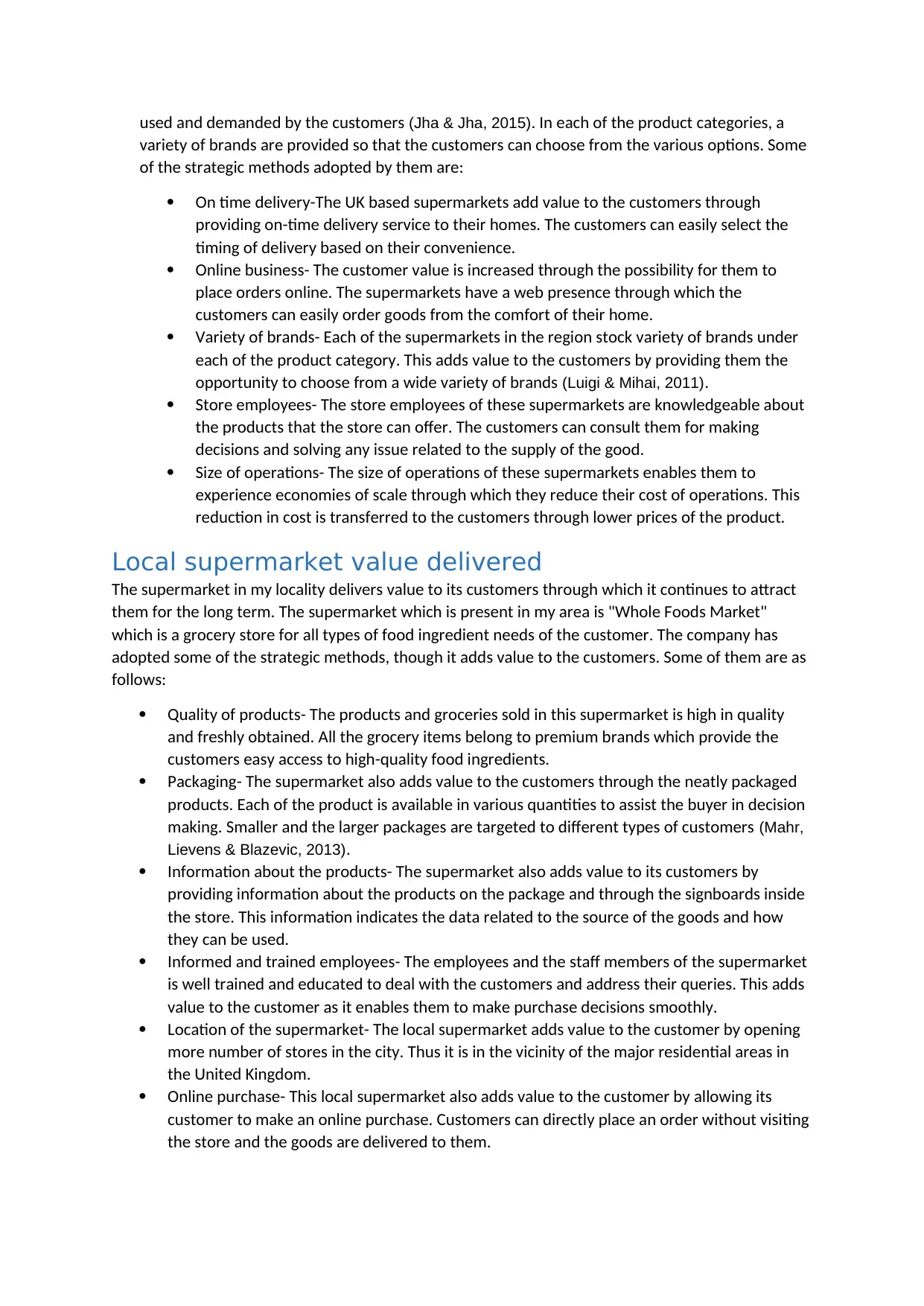
used and demanded by the customers (Jha & Jha, 2015). In each of the product categories, a
variety of brands are provided so that the customers can choose from the various options. Some
of the strategic methods adopted by them are:
On time delivery-The UK based supermarkets add value to the customers through
providing on-time delivery service to their homes. The customers can easily select the
timing of delivery based on their convenience.
Online business- The customer value is increased through the possibility for them to
place orders online. The supermarkets have a web presence through which the
customers can easily order goods from the comfort of their home.
Variety of brands- Each of the supermarkets in the region stock variety of brands under
each of the product category. This adds value to the customers by providing them the
opportunity to choose from a wide variety of brands (Luigi & Mihai, 2011).
Store employees- The store employees of these supermarkets are knowledgeable about
the products that the store can offer. The customers can consult them for making
decisions and solving any issue related to the supply of the good.
Size of operations- The size of operations of these supermarkets enables them to
experience economies of scale through which they reduce their cost of operations. This
reduction in cost is transferred to the customers through lower prices of the product.
Local supermarket value delivered
The supermarket in my locality delivers value to its customers through which it continues to attract
them for the long term. The supermarket which is present in my area is "Whole Foods Market"
which is a grocery store for all types of food ingredient needs of the customer. The company has
adopted some of the strategic methods, though it adds value to the customers. Some of them are as
follows:
Quality of products- The products and groceries sold in this supermarket is high in quality
and freshly obtained. All the grocery items belong to premium brands which provide the
customers easy access to high-quality food ingredients.
Packaging- The supermarket also adds value to the customers through the neatly packaged
products. Each of the product is available in various quantities to assist the buyer in decision
making. Smaller and the larger packages are targeted to different types of customers (Mahr,
Lievens & Blazevic, 2013).
Information about the products- The supermarket also adds value to its customers by
providing information about the products on the package and through the signboards inside
the store. This information indicates the data related to the source of the goods and how
they can be used.
Informed and trained employees- The employees and the staff members of the supermarket
is well trained and educated to deal with the customers and address their queries. This adds
value to the customer as it enables them to make purchase decisions smoothly.
Location of the supermarket- The local supermarket adds value to the customer by opening
more number of stores in the city. Thus it is in the vicinity of the major residential areas in
the United Kingdom.
Online purchase- This local supermarket also adds value to the customer by allowing its
customer to make an online purchase. Customers can directly place an order without visiting
the store and the goods are delivered to them.
variety of brands are provided so that the customers can choose from the various options. Some
of the strategic methods adopted by them are:
On time delivery-The UK based supermarkets add value to the customers through
providing on-time delivery service to their homes. The customers can easily select the
timing of delivery based on their convenience.
Online business- The customer value is increased through the possibility for them to
place orders online. The supermarkets have a web presence through which the
customers can easily order goods from the comfort of their home.
Variety of brands- Each of the supermarkets in the region stock variety of brands under
each of the product category. This adds value to the customers by providing them the
opportunity to choose from a wide variety of brands (Luigi & Mihai, 2011).
Store employees- The store employees of these supermarkets are knowledgeable about
the products that the store can offer. The customers can consult them for making
decisions and solving any issue related to the supply of the good.
Size of operations- The size of operations of these supermarkets enables them to
experience economies of scale through which they reduce their cost of operations. This
reduction in cost is transferred to the customers through lower prices of the product.
Local supermarket value delivered
The supermarket in my locality delivers value to its customers through which it continues to attract
them for the long term. The supermarket which is present in my area is "Whole Foods Market"
which is a grocery store for all types of food ingredient needs of the customer. The company has
adopted some of the strategic methods, though it adds value to the customers. Some of them are as
follows:
Quality of products- The products and groceries sold in this supermarket is high in quality
and freshly obtained. All the grocery items belong to premium brands which provide the
customers easy access to high-quality food ingredients.
Packaging- The supermarket also adds value to the customers through the neatly packaged
products. Each of the product is available in various quantities to assist the buyer in decision
making. Smaller and the larger packages are targeted to different types of customers (Mahr,
Lievens & Blazevic, 2013).
Information about the products- The supermarket also adds value to its customers by
providing information about the products on the package and through the signboards inside
the store. This information indicates the data related to the source of the goods and how
they can be used.
Informed and trained employees- The employees and the staff members of the supermarket
is well trained and educated to deal with the customers and address their queries. This adds
value to the customer as it enables them to make purchase decisions smoothly.
Location of the supermarket- The local supermarket adds value to the customer by opening
more number of stores in the city. Thus it is in the vicinity of the major residential areas in
the United Kingdom.
Online purchase- This local supermarket also adds value to the customer by allowing its
customer to make an online purchase. Customers can directly place an order without visiting
the store and the goods are delivered to them.
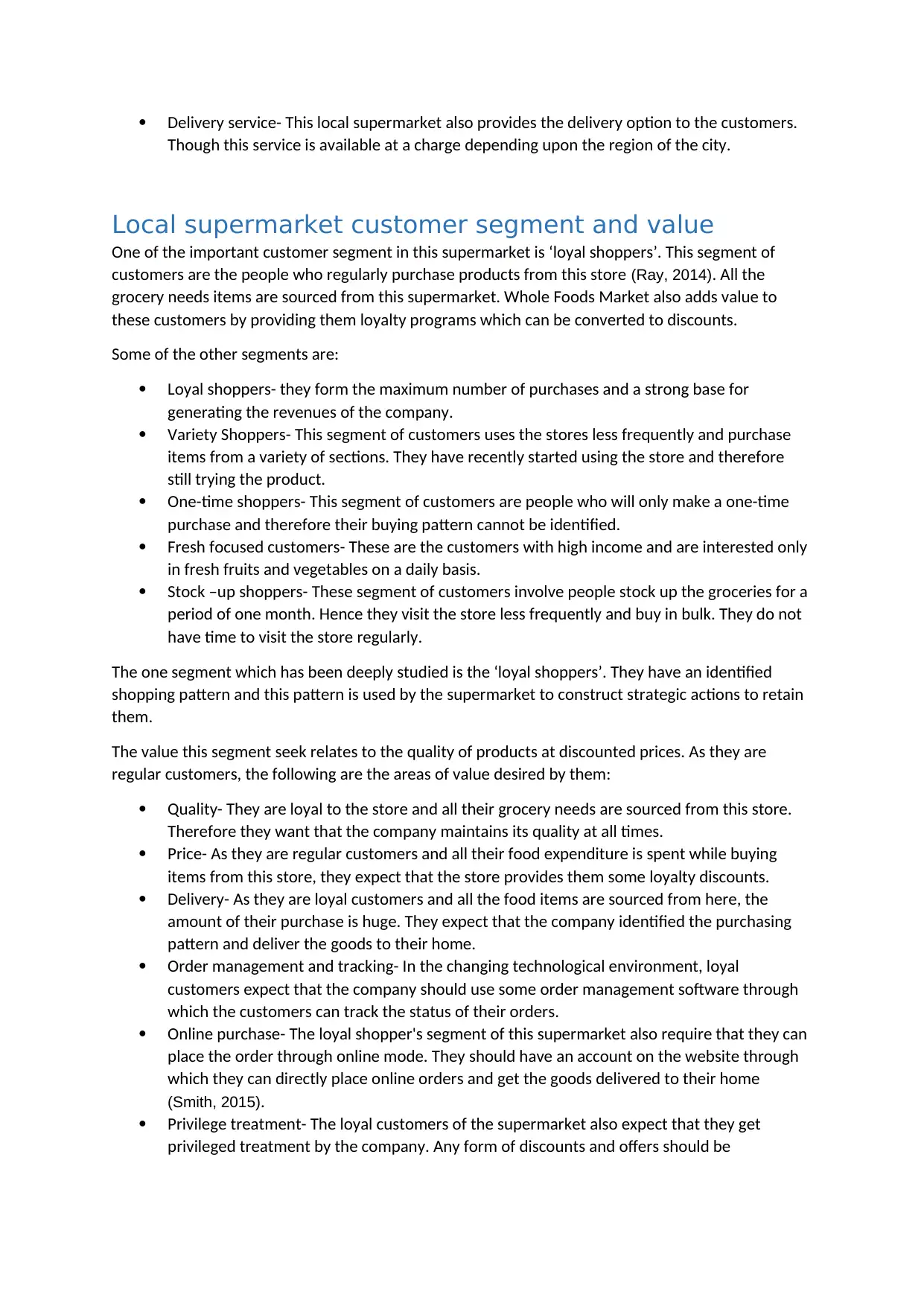
Delivery service- This local supermarket also provides the delivery option to the customers.
Though this service is available at a charge depending upon the region of the city.
Local supermarket customer segment and value
One of the important customer segment in this supermarket is ‘loyal shoppers’. This segment of
customers are the people who regularly purchase products from this store (Ray, 2014). All the
grocery needs items are sourced from this supermarket. Whole Foods Market also adds value to
these customers by providing them loyalty programs which can be converted to discounts.
Some of the other segments are:
Loyal shoppers- they form the maximum number of purchases and a strong base for
generating the revenues of the company.
Variety Shoppers- This segment of customers uses the stores less frequently and purchase
items from a variety of sections. They have recently started using the store and therefore
still trying the product.
One-time shoppers- This segment of customers are people who will only make a one-time
purchase and therefore their buying pattern cannot be identified.
Fresh focused customers- These are the customers with high income and are interested only
in fresh fruits and vegetables on a daily basis.
Stock –up shoppers- These segment of customers involve people stock up the groceries for a
period of one month. Hence they visit the store less frequently and buy in bulk. They do not
have time to visit the store regularly.
The one segment which has been deeply studied is the ‘loyal shoppers’. They have an identified
shopping pattern and this pattern is used by the supermarket to construct strategic actions to retain
them.
The value this segment seek relates to the quality of products at discounted prices. As they are
regular customers, the following are the areas of value desired by them:
Quality- They are loyal to the store and all their grocery needs are sourced from this store.
Therefore they want that the company maintains its quality at all times.
Price- As they are regular customers and all their food expenditure is spent while buying
items from this store, they expect that the store provides them some loyalty discounts.
Delivery- As they are loyal customers and all the food items are sourced from here, the
amount of their purchase is huge. They expect that the company identified the purchasing
pattern and deliver the goods to their home.
Order management and tracking- In the changing technological environment, loyal
customers expect that the company should use some order management software through
which the customers can track the status of their orders.
Online purchase- The loyal shopper's segment of this supermarket also require that they can
place the order through online mode. They should have an account on the website through
which they can directly place online orders and get the goods delivered to their home
(Smith, 2015).
Privilege treatment- The loyal customers of the supermarket also expect that they get
privileged treatment by the company. Any form of discounts and offers should be
Though this service is available at a charge depending upon the region of the city.
Local supermarket customer segment and value
One of the important customer segment in this supermarket is ‘loyal shoppers’. This segment of
customers are the people who regularly purchase products from this store (Ray, 2014). All the
grocery needs items are sourced from this supermarket. Whole Foods Market also adds value to
these customers by providing them loyalty programs which can be converted to discounts.
Some of the other segments are:
Loyal shoppers- they form the maximum number of purchases and a strong base for
generating the revenues of the company.
Variety Shoppers- This segment of customers uses the stores less frequently and purchase
items from a variety of sections. They have recently started using the store and therefore
still trying the product.
One-time shoppers- This segment of customers are people who will only make a one-time
purchase and therefore their buying pattern cannot be identified.
Fresh focused customers- These are the customers with high income and are interested only
in fresh fruits and vegetables on a daily basis.
Stock –up shoppers- These segment of customers involve people stock up the groceries for a
period of one month. Hence they visit the store less frequently and buy in bulk. They do not
have time to visit the store regularly.
The one segment which has been deeply studied is the ‘loyal shoppers’. They have an identified
shopping pattern and this pattern is used by the supermarket to construct strategic actions to retain
them.
The value this segment seek relates to the quality of products at discounted prices. As they are
regular customers, the following are the areas of value desired by them:
Quality- They are loyal to the store and all their grocery needs are sourced from this store.
Therefore they want that the company maintains its quality at all times.
Price- As they are regular customers and all their food expenditure is spent while buying
items from this store, they expect that the store provides them some loyalty discounts.
Delivery- As they are loyal customers and all the food items are sourced from here, the
amount of their purchase is huge. They expect that the company identified the purchasing
pattern and deliver the goods to their home.
Order management and tracking- In the changing technological environment, loyal
customers expect that the company should use some order management software through
which the customers can track the status of their orders.
Online purchase- The loyal shopper's segment of this supermarket also require that they can
place the order through online mode. They should have an account on the website through
which they can directly place online orders and get the goods delivered to their home
(Smith, 2015).
Privilege treatment- The loyal customers of the supermarket also expect that they get
privileged treatment by the company. Any form of discounts and offers should be
⊘ This is a preview!⊘
Do you want full access?
Subscribe today to unlock all pages.

Trusted by 1+ million students worldwide
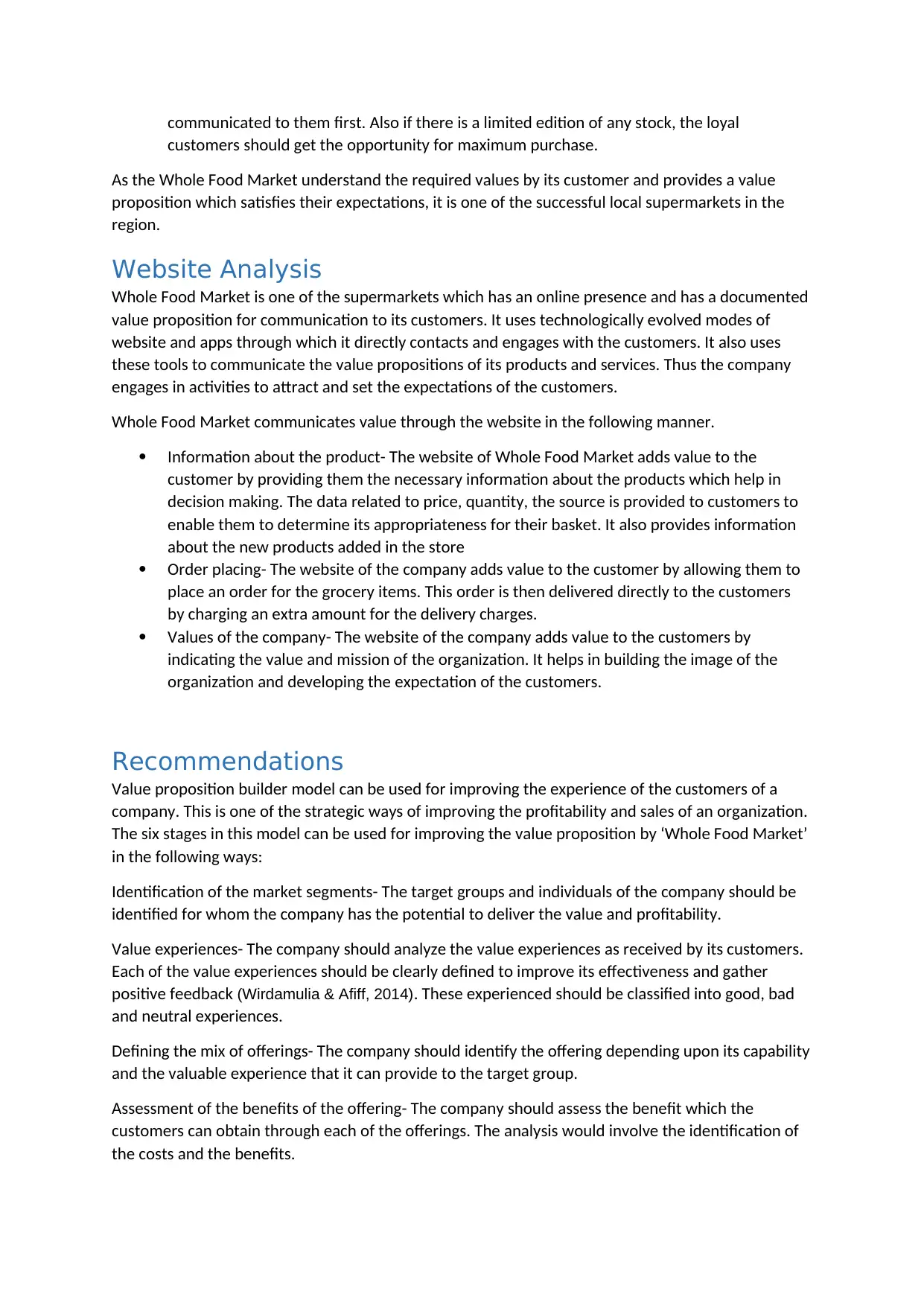
communicated to them first. Also if there is a limited edition of any stock, the loyal
customers should get the opportunity for maximum purchase.
As the Whole Food Market understand the required values by its customer and provides a value
proposition which satisfies their expectations, it is one of the successful local supermarkets in the
region.
Website Analysis
Whole Food Market is one of the supermarkets which has an online presence and has a documented
value proposition for communication to its customers. It uses technologically evolved modes of
website and apps through which it directly contacts and engages with the customers. It also uses
these tools to communicate the value propositions of its products and services. Thus the company
engages in activities to attract and set the expectations of the customers.
Whole Food Market communicates value through the website in the following manner.
Information about the product- The website of Whole Food Market adds value to the
customer by providing them the necessary information about the products which help in
decision making. The data related to price, quantity, the source is provided to customers to
enable them to determine its appropriateness for their basket. It also provides information
about the new products added in the store
Order placing- The website of the company adds value to the customer by allowing them to
place an order for the grocery items. This order is then delivered directly to the customers
by charging an extra amount for the delivery charges.
Values of the company- The website of the company adds value to the customers by
indicating the value and mission of the organization. It helps in building the image of the
organization and developing the expectation of the customers.
Recommendations
Value proposition builder model can be used for improving the experience of the customers of a
company. This is one of the strategic ways of improving the profitability and sales of an organization.
The six stages in this model can be used for improving the value proposition by ‘Whole Food Market’
in the following ways:
Identification of the market segments- The target groups and individuals of the company should be
identified for whom the company has the potential to deliver the value and profitability.
Value experiences- The company should analyze the value experiences as received by its customers.
Each of the value experiences should be clearly defined to improve its effectiveness and gather
positive feedback (Wirdamulia & Afiff, 2014). These experienced should be classified into good, bad
and neutral experiences.
Defining the mix of offerings- The company should identify the offering depending upon its capability
and the valuable experience that it can provide to the target group.
Assessment of the benefits of the offering- The company should assess the benefit which the
customers can obtain through each of the offerings. The analysis would involve the identification of
the costs and the benefits.
customers should get the opportunity for maximum purchase.
As the Whole Food Market understand the required values by its customer and provides a value
proposition which satisfies their expectations, it is one of the successful local supermarkets in the
region.
Website Analysis
Whole Food Market is one of the supermarkets which has an online presence and has a documented
value proposition for communication to its customers. It uses technologically evolved modes of
website and apps through which it directly contacts and engages with the customers. It also uses
these tools to communicate the value propositions of its products and services. Thus the company
engages in activities to attract and set the expectations of the customers.
Whole Food Market communicates value through the website in the following manner.
Information about the product- The website of Whole Food Market adds value to the
customer by providing them the necessary information about the products which help in
decision making. The data related to price, quantity, the source is provided to customers to
enable them to determine its appropriateness for their basket. It also provides information
about the new products added in the store
Order placing- The website of the company adds value to the customer by allowing them to
place an order for the grocery items. This order is then delivered directly to the customers
by charging an extra amount for the delivery charges.
Values of the company- The website of the company adds value to the customers by
indicating the value and mission of the organization. It helps in building the image of the
organization and developing the expectation of the customers.
Recommendations
Value proposition builder model can be used for improving the experience of the customers of a
company. This is one of the strategic ways of improving the profitability and sales of an organization.
The six stages in this model can be used for improving the value proposition by ‘Whole Food Market’
in the following ways:
Identification of the market segments- The target groups and individuals of the company should be
identified for whom the company has the potential to deliver the value and profitability.
Value experiences- The company should analyze the value experiences as received by its customers.
Each of the value experiences should be clearly defined to improve its effectiveness and gather
positive feedback (Wirdamulia & Afiff, 2014). These experienced should be classified into good, bad
and neutral experiences.
Defining the mix of offerings- The company should identify the offering depending upon its capability
and the valuable experience that it can provide to the target group.
Assessment of the benefits of the offering- The company should assess the benefit which the
customers can obtain through each of the offerings. The analysis would involve the identification of
the costs and the benefits.
Paraphrase This Document
Need a fresh take? Get an instant paraphrase of this document with our AI Paraphraser
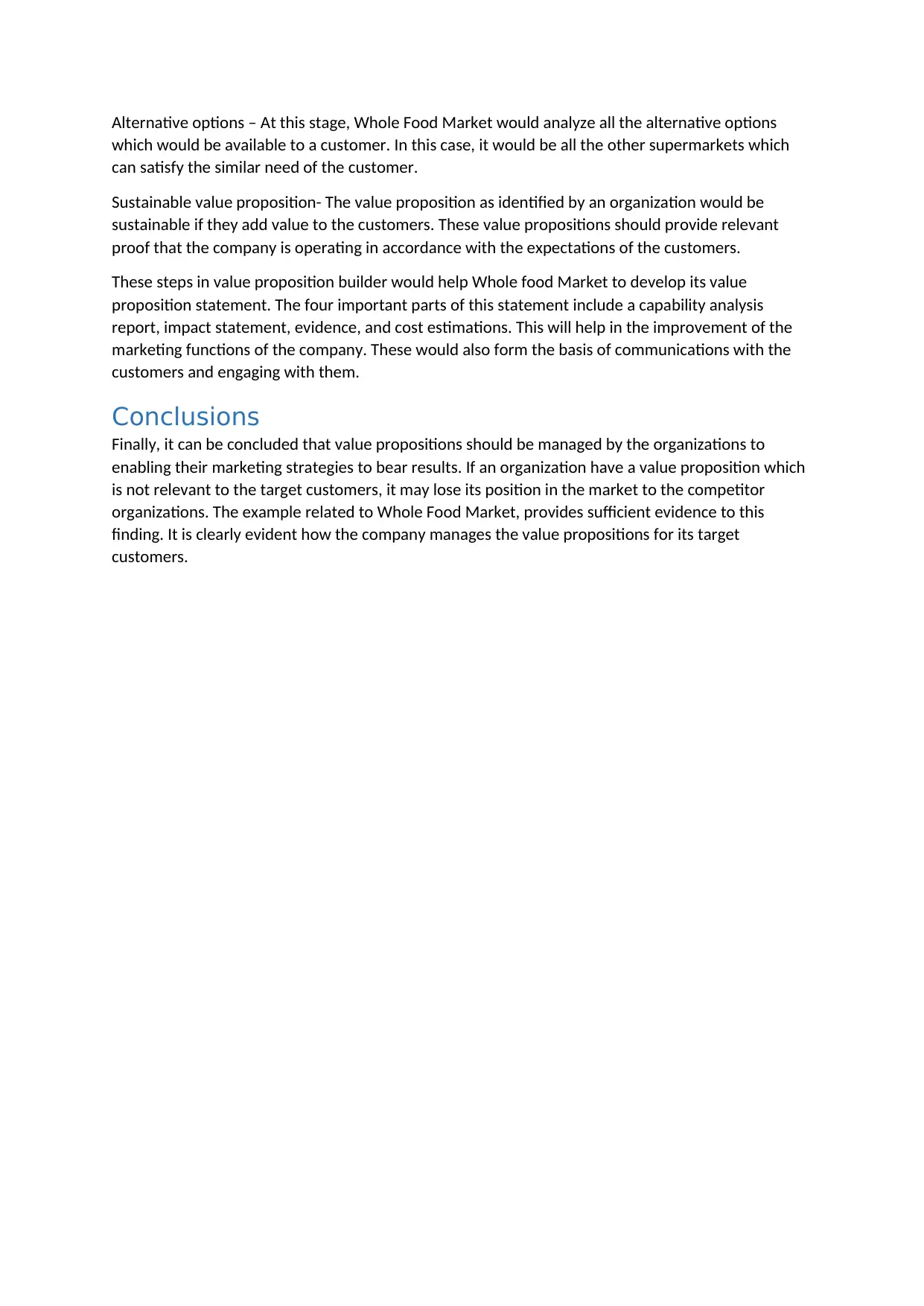
Alternative options – At this stage, Whole Food Market would analyze all the alternative options
which would be available to a customer. In this case, it would be all the other supermarkets which
can satisfy the similar need of the customer.
Sustainable value proposition- The value proposition as identified by an organization would be
sustainable if they add value to the customers. These value propositions should provide relevant
proof that the company is operating in accordance with the expectations of the customers.
These steps in value proposition builder would help Whole food Market to develop its value
proposition statement. The four important parts of this statement include a capability analysis
report, impact statement, evidence, and cost estimations. This will help in the improvement of the
marketing functions of the company. These would also form the basis of communications with the
customers and engaging with them.
Conclusions
Finally, it can be concluded that value propositions should be managed by the organizations to
enabling their marketing strategies to bear results. If an organization have a value proposition which
is not relevant to the target customers, it may lose its position in the market to the competitor
organizations. The example related to Whole Food Market, provides sufficient evidence to this
finding. It is clearly evident how the company manages the value propositions for its target
customers.
which would be available to a customer. In this case, it would be all the other supermarkets which
can satisfy the similar need of the customer.
Sustainable value proposition- The value proposition as identified by an organization would be
sustainable if they add value to the customers. These value propositions should provide relevant
proof that the company is operating in accordance with the expectations of the customers.
These steps in value proposition builder would help Whole food Market to develop its value
proposition statement. The four important parts of this statement include a capability analysis
report, impact statement, evidence, and cost estimations. This will help in the improvement of the
marketing functions of the company. These would also form the basis of communications with the
customers and engaging with them.
Conclusions
Finally, it can be concluded that value propositions should be managed by the organizations to
enabling their marketing strategies to bear results. If an organization have a value proposition which
is not relevant to the target customers, it may lose its position in the market to the competitor
organizations. The example related to Whole Food Market, provides sufficient evidence to this
finding. It is clearly evident how the company manages the value propositions for its target
customers.
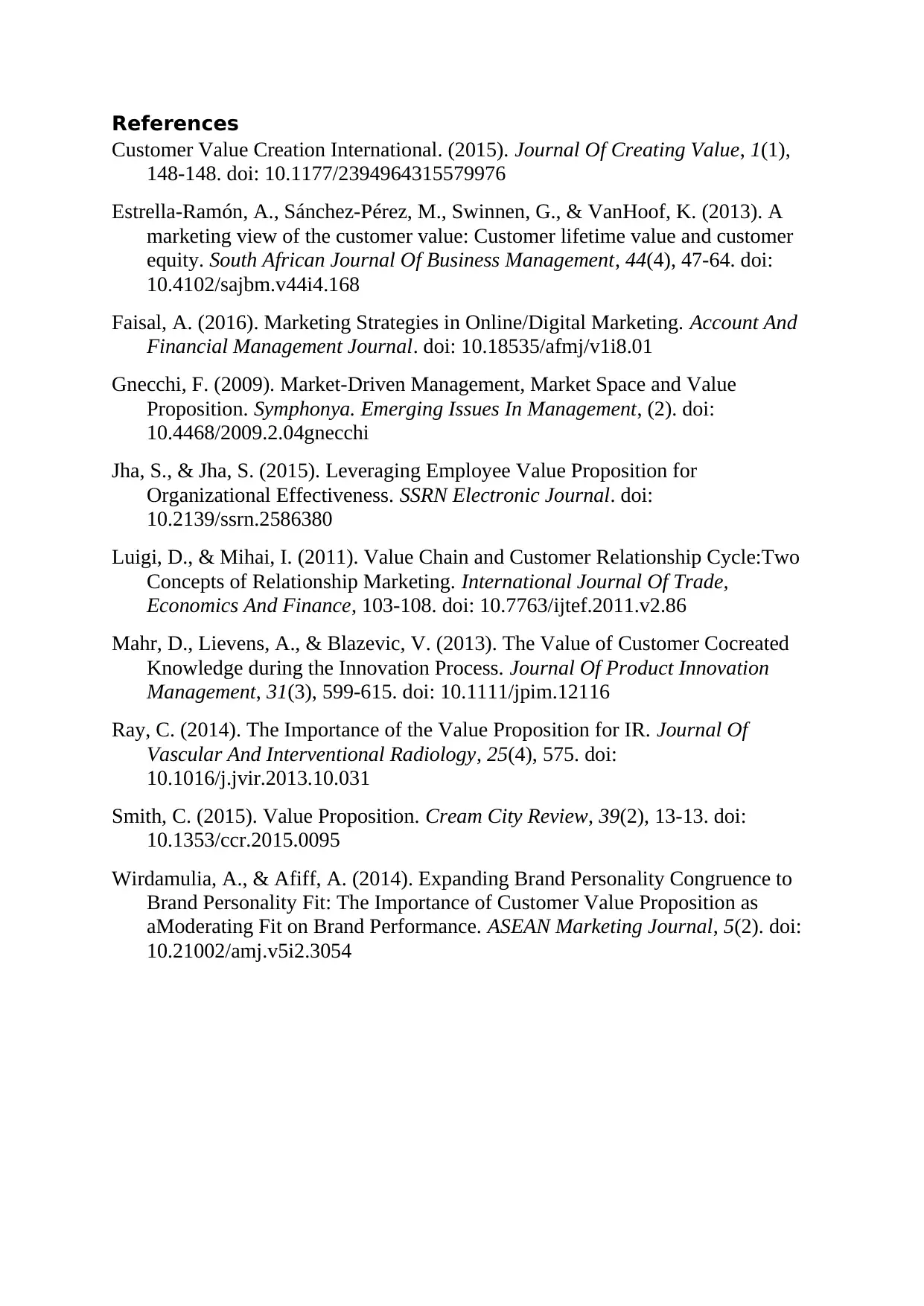
References
Customer Value Creation International. (2015). Journal Of Creating Value, 1(1),
148-148. doi: 10.1177/2394964315579976
Estrella-Ramón, A., Sánchez-Pérez, M., Swinnen, G., & VanHoof, K. (2013). A
marketing view of the customer value: Customer lifetime value and customer
equity. South African Journal Of Business Management, 44(4), 47-64. doi:
10.4102/sajbm.v44i4.168
Faisal, A. (2016). Marketing Strategies in Online/Digital Marketing. Account And
Financial Management Journal. doi: 10.18535/afmj/v1i8.01
Gnecchi, F. (2009). Market-Driven Management, Market Space and Value
Proposition. Symphonya. Emerging Issues In Management, (2). doi:
10.4468/2009.2.04gnecchi
Jha, S., & Jha, S. (2015). Leveraging Employee Value Proposition for
Organizational Effectiveness. SSRN Electronic Journal. doi:
10.2139/ssrn.2586380
Luigi, D., & Mihai, I. (2011). Value Chain and Customer Relationship Cycle:Two
Concepts of Relationship Marketing. International Journal Of Trade,
Economics And Finance, 103-108. doi: 10.7763/ijtef.2011.v2.86
Mahr, D., Lievens, A., & Blazevic, V. (2013). The Value of Customer Cocreated
Knowledge during the Innovation Process. Journal Of Product Innovation
Management, 31(3), 599-615. doi: 10.1111/jpim.12116
Ray, C. (2014). The Importance of the Value Proposition for IR. Journal Of
Vascular And Interventional Radiology, 25(4), 575. doi:
10.1016/j.jvir.2013.10.031
Smith, C. (2015). Value Proposition. Cream City Review, 39(2), 13-13. doi:
10.1353/ccr.2015.0095
Wirdamulia, A., & Afiff, A. (2014). Expanding Brand Personality Congruence to
Brand Personality Fit: The Importance of Customer Value Proposition as
aModerating Fit on Brand Performance. ASEAN Marketing Journal, 5(2). doi:
10.21002/amj.v5i2.3054
Customer Value Creation International. (2015). Journal Of Creating Value, 1(1),
148-148. doi: 10.1177/2394964315579976
Estrella-Ramón, A., Sánchez-Pérez, M., Swinnen, G., & VanHoof, K. (2013). A
marketing view of the customer value: Customer lifetime value and customer
equity. South African Journal Of Business Management, 44(4), 47-64. doi:
10.4102/sajbm.v44i4.168
Faisal, A. (2016). Marketing Strategies in Online/Digital Marketing. Account And
Financial Management Journal. doi: 10.18535/afmj/v1i8.01
Gnecchi, F. (2009). Market-Driven Management, Market Space and Value
Proposition. Symphonya. Emerging Issues In Management, (2). doi:
10.4468/2009.2.04gnecchi
Jha, S., & Jha, S. (2015). Leveraging Employee Value Proposition for
Organizational Effectiveness. SSRN Electronic Journal. doi:
10.2139/ssrn.2586380
Luigi, D., & Mihai, I. (2011). Value Chain and Customer Relationship Cycle:Two
Concepts of Relationship Marketing. International Journal Of Trade,
Economics And Finance, 103-108. doi: 10.7763/ijtef.2011.v2.86
Mahr, D., Lievens, A., & Blazevic, V. (2013). The Value of Customer Cocreated
Knowledge during the Innovation Process. Journal Of Product Innovation
Management, 31(3), 599-615. doi: 10.1111/jpim.12116
Ray, C. (2014). The Importance of the Value Proposition for IR. Journal Of
Vascular And Interventional Radiology, 25(4), 575. doi:
10.1016/j.jvir.2013.10.031
Smith, C. (2015). Value Proposition. Cream City Review, 39(2), 13-13. doi:
10.1353/ccr.2015.0095
Wirdamulia, A., & Afiff, A. (2014). Expanding Brand Personality Congruence to
Brand Personality Fit: The Importance of Customer Value Proposition as
aModerating Fit on Brand Performance. ASEAN Marketing Journal, 5(2). doi:
10.21002/amj.v5i2.3054
⊘ This is a preview!⊘
Do you want full access?
Subscribe today to unlock all pages.

Trusted by 1+ million students worldwide
1 out of 9
Related Documents
Your All-in-One AI-Powered Toolkit for Academic Success.
+13062052269
info@desklib.com
Available 24*7 on WhatsApp / Email
![[object Object]](/_next/static/media/star-bottom.7253800d.svg)
Unlock your academic potential
Copyright © 2020–2025 A2Z Services. All Rights Reserved. Developed and managed by ZUCOL.





